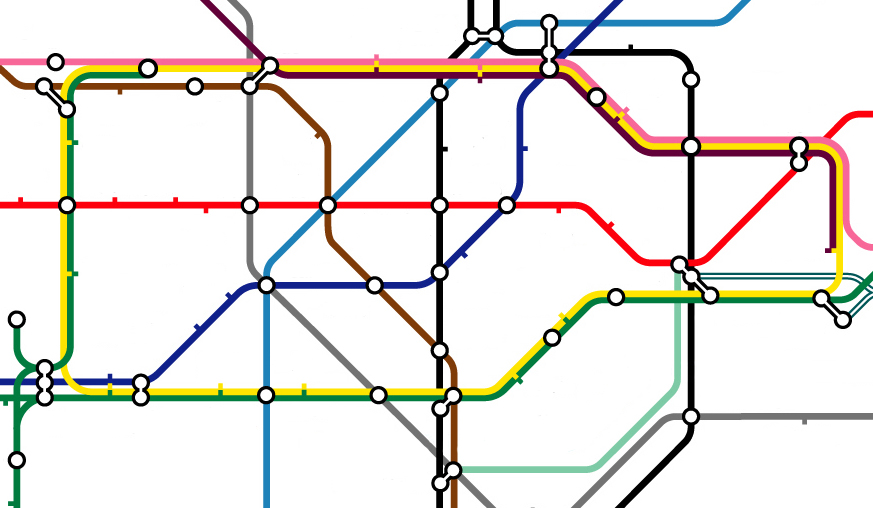The similarities between cancer and the London Underground may not immediately leap to mind, but the parallels between them are driving an exciting new area of research that could open up fresh approaches to treatment.
Within our cells, thousands of proteins are wired together through dynamic – and complex – signalling pathways, sending out instructions to change, grow, move, cope with stress, live or die. Scientists know quite a lot about many of the individual proteins within these signalling pathways, but far less about how they intricately intertwine within networks – networks that look quite a lot like the London Underground map.
Jumbling up of signalling networks is now recognised as a key cause of cancer, and researchers at The Institute of Cancer Research, London, are busy trying to understand just how these signals work – and how the wiring goes wrong.
Dr Chris Bakal heads the dynamical cell systems team, which is mapping the architecture and dynamics of cell signalling networks. “Understanding how a pathway works may uncover a weak spot in the cancer armour that we can target with drugs. Or we can see how drug resistance is happening,” Dr Bakal says. “Signalling networks are organised like many other kinds of networks, such as the London tube lines, where there are many different routes to take if a blockade occurs. For example, if you normally take the underground using the Picadilly line from Kings Cross to South Kensington, but one day Hyde Park Station is closed, you can also take the Circle line. Similarly, many cancers are initially caused by biochemical activity on a single part of the network. While a single drug can cause a blockade in the line, and perhaps treat a cancer temporarily, cancer cells develop resistance to drugs by activating other biochemical pathways that bypass the drug-induced blockade. So in order to treat cancers effectively, we need to generate maps of cellular networks, and determine drug combinations that can shut down multiple lines and pathways at the same time. Without those maps you wouldn’t know which combinations will work.”
Dr Bakal’s team at The Institute of Cancer Research (ICR) – whose work is funded by Cancer Research UK, the Wellcome Trust, and the Biotechnology and Biological Sciences Research Council – is using a combination of functional genomic, proteomic and computational technologies to figure out what each component does within a pathway. “We can block the action of specific genes using RNA interference, which uses small sequences of RNA that can bind to matching genes in a sample,” Dr Bakal explains. “So essentially, we can turn genes off one at a time, and see what it does to cells.” With the assistance of robotics, advanced microscopy and computational algorithms that can process images automatically – much like face recognition software – the team can inhibit all 25,000 genes one at a time in a single cancer cell, and determine the effect of each gene. Mathematical approaches are used, turning these datasets into signalling networks. One strand of research that interests Dr Bakal’s team is mapping signalling networks that control the shape changes tumour cells make during metastasis – where cells have taken on the ability to move from the initial tumour site to different parts of the body.
“I am totally fascinated by how our cells can take on so many different shapes,” Dr Bakal states. “How is it that all your cells have the same genetic material, but one cell can become a thin-branched neuron that is many feet long, whereas others become flat, large skin cells?” Understanding cell shape is highly important to developing insight into metastasis, as metastatic cells must change their shape in radical ways to spread throughout the body. For example, in the circulatory system and in soft tissues, metastatic cells adopt a very rounded shape. However, when travelling across bone and other hard tissues, they must adopt an elongated shape. Without the ability to assume these shapes, cancer cells cannot metastasise. “It’s like us getting across ice and water – we need different pieces of equipment to do this,” Dr Bakal explains. “By understanding how these shape changes work, we might find a way to control metastatic cancer through drugs or other therapies. By describing cellular networks that control shape, we can start to understand how cell shape is linked to environmental signals.”
Dr Bakal hopes that his research can help understand how cancer networks operate, so doctors can find ways of blocking multiple potential resistance pathways. Using the London Underground analogy again, it would involve shutting down all the available train lines that would connect your starting point with your destination. Anyone who has tried travelling across London on a Bank Holiday weekend will know exactly what he means.
